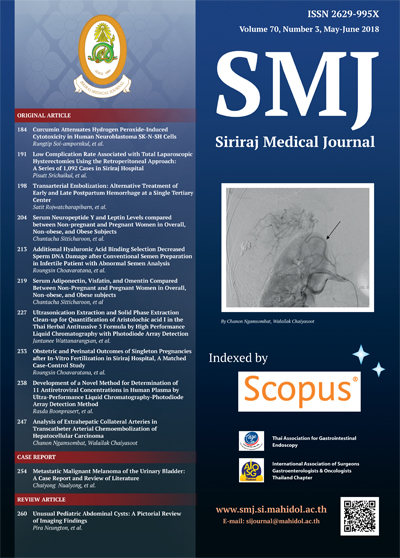Ultrasonication Extraction and Solid Phase Extraction Clean-up for Quantification of Aristolochic Acid I in the Thai Herbal Antitussive 3 Formula by High Performance Liquid Chromatography with Photodiode Array Detection
Keywords:
Aristolochic acid; Aristolochia tagala Cham.; Thai Herbal Antitussive 3 Formula; High Performance Liquid Chromatography (HPLC)Abstract
Objective: To establish a reliable High Performance Liquid Chromatography method with photodiode array detection (HPLC-PDA) and a suitable extraction method for identification and quantification of Aristolochic acid I (AA-I) in 3 different sample types, i.e. Aristolochia tagala Cham.(ATC), Thai Herbal Antitussive 3 Formula (ATF3), and Thai Herbal Antitussive 3 Formula containing ATC (ATF3+ATC).
Methods: Two extraction methods, ultrasonication extraction (UE) and solid phase extraction (SPE), were used in the present study. Reversed phase separations were performed with a SunFire C18 column and HPLC-PDA.
Mobile phase was performed by 1 mL/min infusion of mixture of 0.1% o-phosphoric acid and methanol (35:65).
Results: Calibration curve showed a good linearity with R2 equal to 0.9986. Every sample type has been analyzed. While the concentration of AA-I in ATF3 cannot be determined due to the absence of the AA-I peak, the AA-I concentrations in ATC and ATF3+ATC were 7.50-11.34 and 6.78-11.77 mg/mL respectively. In comparison with UE, SPE is more effective in eradication of the interfering compounds and improves the absorbance spectrum of the peak and increases extraction efficiency.
Conclusion: A reliable HPLC-PDA and SPE methods for identification and quantification of AA-I in ATF3+ATC, ATF3, and ATC were established in the present study. The SPE was more effective than UE in the pretreatment step.
Downloads
Published
How to Cite
Issue
Section
License
Authors who publish with this journal agree to the following conditions:
Copyright Transfer
In submitting a manuscript, the authors acknowledge that the work will become the copyrighted property of Siriraj Medical Journal upon publication.
License
Articles are licensed under a Creative Commons Attribution-NonCommercial-NoDerivatives 4.0 International License (CC BY-NC-ND 4.0). This license allows for the sharing of the work for non-commercial purposes with proper attribution to the authors and the journal. However, it does not permit modifications or the creation of derivative works.
Sharing and Access
Authors are encouraged to share their article on their personal or institutional websites and through other non-commercial platforms. Doing so can increase readership and citations.











